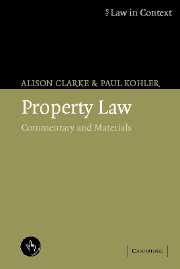Book contents
- Frontmatter
- Contents
- Preface
- Acknowledgments
- Table of cases
- Table of statutes
- Table of statutory instruments
- Table of treaties
- Table of EC legislation
- Part 1 The concept of property
- 1 Property law: the issues
- 2 What we mean by ‘property’
- 3 Justifications for property rights
- 4 Allocating property rights
- Part 2 The nature of proprietary interests
- Part 3 The acquisition and disposition of property interests
- Part 4 Proprietary relationships
- Bibliography
- Index
1 - Property law: the issues
Published online by Cambridge University Press: 05 June 2012
- Frontmatter
- Contents
- Preface
- Acknowledgments
- Table of cases
- Table of statutes
- Table of statutory instruments
- Table of treaties
- Table of EC legislation
- Part 1 The concept of property
- 1 Property law: the issues
- 2 What we mean by ‘property’
- 3 Justifications for property rights
- 4 Allocating property rights
- Part 2 The nature of proprietary interests
- Part 3 The acquisition and disposition of property interests
- Part 4 Proprietary relationships
- Bibliography
- Index
Summary
Basic definition
To put it at its simplest, property law is about the legally recognised relationships we have with each other in respect of things. We will want to expand and qualify this statement later – what kinds of relationship, what kinds of thing? – but our starting point is an introduction to the moral, political, social and economic context in which property law operates.
Illustrative example
Consider the following hypothetical situation, a variation of facts which actually occurred in California in 1976 and which became the subject of a celebrated decision of the Supreme Court of California, Moore v. Regents of the University of California, 51 Cal 3d 120; 793 P 2d 479 (1990).
John went into hospital to undergo an exploratory operation to aid diagnosis of unexplained stomach pains he had been suffering. During the course of the operation, Dr A removed tissue from John's stomach lining and stored it so that he could carry out further analysis if his initial diagnosis proved to be incorrect. No further analysis proved necessary: Dr A's initial diagnosis was confirmed, John was successfully treated and made a full recovery, and Dr A gave no further thought to the tissue sample.
By chance, however, it became included in material that Dr B was using in research he was carrying out at the hospital. This material included primary cells (i.e. cells taken directly from the body) taken from a number of different patients in the hospital.
- Type
- Chapter
- Information
- Property LawCommentary and Materials, pp. 3 - 16Publisher: Cambridge University PressPrint publication year: 2005



